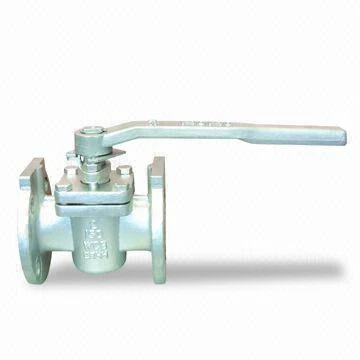1. Working principle of plug valves
Plug valves are one of the most widely used valves for both on/off and throttling services. Their design is fairly simple. Plug valve is comprised of three main parts: body, cover and plug. The plug is a cylindrical, tapered, or generally cone-shaped device that can be rotated inside the valve body to control flow through the valve. The plugs have one or more hollow passageways going sideways through the plug, so that fluid can flow through the plug when the valve is open. The valve is opened by rotation, with the plug itself being the only element that is capable of movement. Plug Valve is simple and often economical. Early models of plug valve used metal-to-metal seals that were nonlubricated. This design is still used, but problems with galling and sticking limit their usefulness.
In order to expand the application range of plug valve, many new structures have been developed. lubricated plug valve is the most important type. The use of lubricant between the plug face and the seat eliminates most of these problems. The lubricant helps to control leakage around the plug, and reduces wear between the valve contact surfaces, and slightly lifts the plug to reduce the operating torque required to operate the valve.
2. Characteristics of plug valves
1) Fluid passes in straight way, small resistance, easy to open and close quickly.
2) Plug valve is mainly used in low pressure, and medium temperature is not high.
3) Plug valve in the pipeline is mainly used to cut off, lift and change the direction of medium flow. It is easily adaptable to multi-channel configurations so that one valve can have two, three, or even four different flow paths, simplifying the design of the piping system and reducing the number of valves and fittings required in the equipment.
3. Maintenance of plug valves
1) Check the plug valve every month, and maintain the plug valve quarterly in January, April, July and October every year on the basis of monthly inspection.
2) Check the operating flexibility of the plug valve. The plug valve should ensure that one person can operate without adding the break bar.
3) Check all sealing points of plug valve body and flange for leakage prevention.
4) Check plug valve for internal leakage prevention.
5) Check plug valve actuator for water collection and lack of lubricant.
6) For the maintenance of the plug valve actuator, if it is found that the lubricant in the actuator does not cover all the contact surfaces of the transmission mechanism, the old lubricant shall be removed completely and then sufficient new lubricant shall be applied on all the contact surfaces.

Plug valves are one of the most widely used valves for both on/off and throttling services. Their design is fairly simple. Plug valve is comprised of three main parts: body, cover and plug. The plug is a cylindrical, tapered, or generally cone-shaped device that can be rotated inside the valve body to control flow through the valve. The plugs have one or more hollow passageways going sideways through the plug, so that fluid can flow through the plug when the valve is open. The valve is opened by rotation, with the plug itself being the only element that is capable of movement. Plug Valve is simple and often economical. Early models of plug valve used metal-to-metal seals that were nonlubricated. This design is still used, but problems with galling and sticking limit their usefulness.
In order to expand the application range of plug valve, many new structures have been developed. lubricated plug valve is the most important type. The use of lubricant between the plug face and the seat eliminates most of these problems. The lubricant helps to control leakage around the plug, and reduces wear between the valve contact surfaces, and slightly lifts the plug to reduce the operating torque required to operate the valve.
2. Characteristics of plug valves
1) Fluid passes in straight way, small resistance, easy to open and close quickly.
2) Plug valve is mainly used in low pressure, and medium temperature is not high.
3) Plug valve in the pipeline is mainly used to cut off, lift and change the direction of medium flow. It is easily adaptable to multi-channel configurations so that one valve can have two, three, or even four different flow paths, simplifying the design of the piping system and reducing the number of valves and fittings required in the equipment.
3. Maintenance of plug valves
1) Check the plug valve every month, and maintain the plug valve quarterly in January, April, July and October every year on the basis of monthly inspection.
2) Check the operating flexibility of the plug valve. The plug valve should ensure that one person can operate without adding the break bar.
3) Check all sealing points of plug valve body and flange for leakage prevention.
4) Check plug valve for internal leakage prevention.
5) Check plug valve actuator for water collection and lack of lubricant.
6) For the maintenance of the plug valve actuator, if it is found that the lubricant in the actuator does not cover all the contact surfaces of the transmission mechanism, the old lubricant shall be removed completely and then sufficient new lubricant shall be applied on all the contact surfaces.

